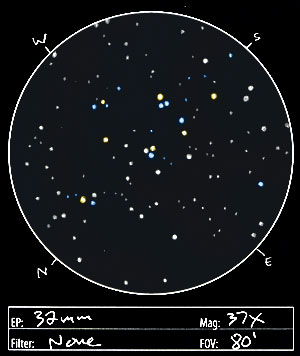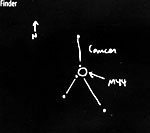
Observation Notes:
 This is a bright, bold, wide-open, beautiful cluster. The stars fill the view and the brightest like to form triangular trios. The colors are a brilliant yellow, blue and white. "The Beehive" seems like a very appropriate name. Within the view, there didn't appear to be any noticeable concentration of stars. The brightest tended to be yellow. It was also easily visible naked-eye as a fuzzy patch in the center of Cancer.
This is a bright, bold, wide-open, beautiful cluster. The stars fill the view and the brightest like to form triangular trios. The colors are a brilliant yellow, blue and white. "The Beehive" seems like a very appropriate name. Within the view, there didn't appear to be any noticeable concentration of stars. The brightest tended to be yellow. It was also easily visible naked-eye as a fuzzy patch in the center of Cancer.
Factoids:
M44 is known as Praesepe (Latin for "manger") or the Beehive cluster. Because it is easily visible to the naked eye, it has been known since preshistoric times. It was mentioned by Aratos in 260 BCE as a "Little Mist", by Hipparcos in 130 BCE as a "Little Cloud" or "Cloudy Star", by Ptolemy as "The Nebulous Mass in the Breast [of Cancer]", and by Johann Bayer in 1600 CE as "Nubilum" (Cloudy object). Galileo was the first to resolve it, and noted, "The nebula calle Praesepe, which is not one star only, but a mass of more than 40 small stars." Charles Messier catalogued it in 1764.
Two hundred stars are confirmed members of the cluster. It is 577 light years away and is estimated to be 730 million years old. It's been determined that the proper motion of M44 coincides with the Hyades which are estimated to be 790 million years. So, even though separated by hundreds of light years, it is believed both clusters had a common origin in the same nebula that existed 700 to 800 million years ago. In support of this, both stellar populatins are similar--containing red giants and some white dwarfs.
| Subject | M44 (NGC 2632) | |
| Classification | Open Cluster | |
| Position | Cancer [RA: 08:40.1 / Dec: +19:59]* | |
| Size* | 95' | |
| Brightness* | 3.7 | |
| Date/Time | February 4, 2005 - 1:00 AM (February 4, 2005 - 08:00 UT) | |
| Observing Loc. | Flagstaff, AZ - Home | |
| Instrument | Orion SVP 6LT Reflector (150 mm dia./1200 mm F/L) | |
| Eyepieces/Mag. | 32 mm (37X) | |
| Conditions | Clear, 28�F | |
| Seeing | 3/10 | |
| Transparency | Mag 5.2 | |
| Sources | SEDS |
*Based on published data.




